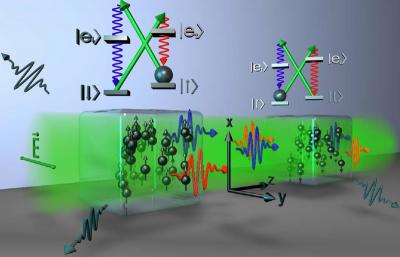Quantum optical link sets new entanglement time record: one hour
August 18, 2011

Two clouds of cesium atoms entangled using laser light, which normally causes the atoms to spontaneously emit photons in all directions. However, the NBI team succeeded in maintaining entanglement for an hour (credit: Christine Muschik)
Niels Bohr Institute researchers have succeeded in setting a new record by maintaining the entanglement of the spins of two gas clouds of cesium atoms for up to an hour.
Quantum communication could be an option for the absolutely secure transfer of data. The key component in quantum communication over long distances is the special phenomenon called entanglement between two atomic systems. Two separate entangled systems have a ghostlike connection even when they are placed at a large distance without being directly connected to each other.
However, entanglement between two atomic systems is very fragile and up until now researchers have only been able to maintain the entanglement for a fraction of a second.
Maintaining entanglement
To create the entangled state of the two atomic clouds, researchers use light. When you shine a laser beam on atoms, photons are absorbed and subsequently re-emitted spontaneously. This process has been an impediment to the experiments because it is uncontrolled.
“Now we have managed to control this ‘spontaneous’ process and use it,” explains Eugene Polzik, Professor and Director of the Danish National Research Foundation Center, Quantop at the Niels Bohr Institute at the University of Copenhagen. The research group conducted experiments with entanglement using two clouds of cesium atoms placed in separate glass containers. By illuminating both clouds of atoms with laser light, the collective spins of the atoms are manipulated. The two atomic clouds become entangled, which means that some of their properties are correlated.
But the atoms normally emit photons in all directions and this causes the entanglement to disappear. This usually happens in a fraction of a second.
“We have developed a technique where we renew the entanglement as fast as it disappears. In this way, we have been able to maintain the entanglement between the two atomic clouds as long as the experiment lasted — up to an hour,” explains Hanna Krauter, who is a quantum physicist and researcher at Quantop at the Niels Bohr Institute.
The research was conducted in collaboration with the Max Planck Institute of Quantum Optics in Germany, where they have been working with the theoretical models. Theoretical physicists have suggested similar techniques for about five years, but it is only now that the NBI team has succeeded in conducting the physical experiments based on these methods and getting them to work.
“The breakthrough has great potential and provides, among other things, a new approach to quantum communication,” explains Professor Eugene Polzik. “It is a step towards getting quantum communication to function in practice — not just in the laboratory, but also in the real world of networking on the Internet.
“In addition, it means an improvement of ultra-precise measurements of miniscule magnetic fields with atomic magnetometers. Sensitive magnetometers could be used to measure electrical activity in the human brain and heart.”